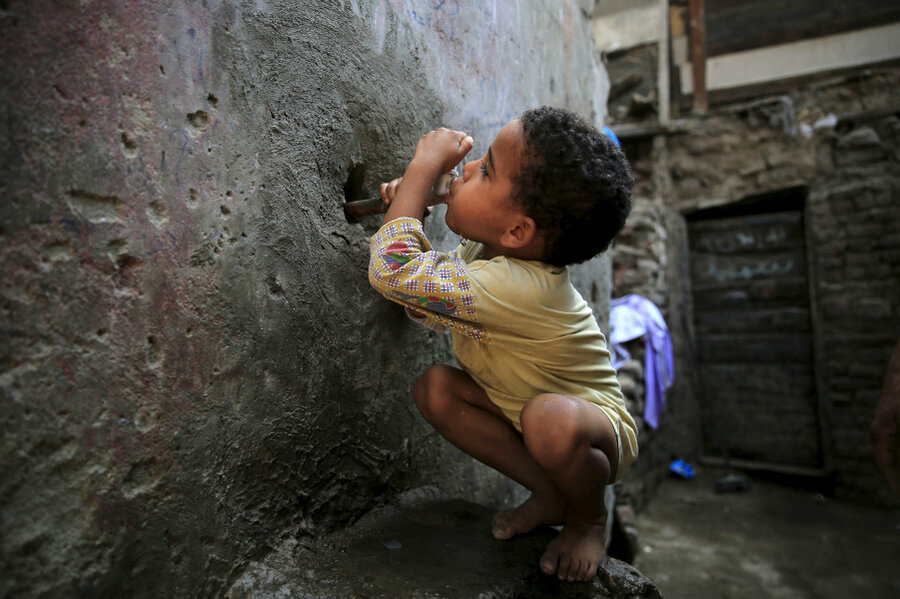Three cool solutions to the clean water problem
Loading...
You probably don’t have to think twice about clean water. It’s as close as a faucet, as dependable as spring rain.
But, right now, 783 million people lack access to clean and safe water.
Providing clean, safe water across the globe is a huge undertaking, with a price tag that ranges from $10 billion to $175 billion. But several solutions – from drinking straws to a “drinkable” book – are showing that technology doesn’t have to be massive to make a difference.
One-in-nine people don’t have clean water, and that means disease, death, and a drain on already-struggling economies.
Half of all hospital beds worldwide are filled with people with easily preventable, water-related diseases, like diarrhea and cholera. These diseases kill 3.4 million people a year and claim the life of a child every minute.
Finding water is a time-consuming, grueling task that falls mostly to women and children. Some 140 million hours each day – hours not spent on income-generating activities – are taken up by collecting water.
Children lose 443 million days of school to water-related diseases, missing precious days when they could be learning the skills needed to lift them out of poverty. In addition to that distressing statistic, half of the schools in the developing world lack adequate water and sanitation facilities.
Safe water is a valuable investment. Each dollar invested in water and sanitation produces $3 to $34 in returns of increased productivity. Finding solutions to the water crisis, no matter how big or small, are critical to saving lives and ending poverty.
It is important to invest in infrastructure that will serve long term needs, but immediate, short-term solutions are necessary as well. Affordable, easy-to-use purification devices reduce water-related diseases and eliminates the need to boil water – itself a polluting and resource-intense practice.
Among the many large and humble water treatment programs, three small water purification devices are making clean and safe water more attainable.
LifeStraw
This water purifier, designed by the Swiss company Vestergaard Fradsen, is simple to use: Just put one end of the nine-inch straw in unfiltered water and suck in clean water. The straw filters out contaminants using hollow fiber technology; no chemicals are involved.
With each purchase of a LifeStraw, one school child in the developing world is provided with safe drinking water for an entire year through Vestergaard Fraden’s larger institutional water filters. In 2014, the company and its distribution partners delivered 1,646 community purifiers to 301 schools, reaching 157,975 schoolchildren.
Through its Carbon for Water Program, LifeStraw sells carbon credits to provide free Family LifeStaw filters to families in developing countries.
So far, 877,505 filters have been distributed, reaching more than 4 million people.
SONO Water Filters
This simple, cost effective, and locally produced filtration device cleans deadly arsenic contamination from groundwater in Bangladesh, the result of “tube wells” installed by well-meaning aid organizations in the 1970s. The wells draw water from aquifers contaminated with arsenic and expose 35 million to 77 million people to arsenic poisoning, which causes skin lesions, cancer, and death.
Experts classified the arsenic contamination of groundwater in Bangladesh as the largest mass poisoning of a population in history.
Abdul Hussam, a professor of chemistry at George Mason University, recognized this catastrophe and sought to do something about it. He designed the SONO Filter in 2006 to eliminate arsenic, as well as to increase access to clean water for the 23 million Bangladeshis who live without it.
The SONO Filter is a large bucket filled with iron, sand, gravel, and charcoal that filters out arsenic and other toxic chemicals and bacteria.
The simple design costs only $35 and can filter 100 liters (26 gallons) a day for up to 14 years. UNICEF and other aid organizations have distributed about 225,000 free SONO filters throughout Bangladesh, Nepal, and India.
The Drinkable Book
The “book” is a water filter and instruction manual for how and why to clean drinking water. It’s made of a new type of paper, created by scientists from Carnegie Mellon University and the University of Virginia, that costs only pennies to produce. The paper is coated with silver nanoparticles that attract bacteria and toxins when water flows through it, leaving the water 99.9 percent pure. Not only does each book provide clean water for one person for three years, but it also serves as an instruction manual for healthy sanitation practices.
WATERisLIFE, an aid organization that works with communities to develop safe water systems, joined with the Drinkable Book’s creator, researcher Theresa Dankovich of Carnegie Mellon, to campaign for the funds to move the product toward wide-scale distribution. Currently, WATERisLIFE is working on printing the books in different languages and developing new teaching methods.
WATERisLIFE plans to start distributing the book globally this winter.
The water crisis is real and is getting worse. These three products collectively reach only 4 million of the 783 million people in need. And, by 2025, 2.8 billion people will live in countries with water scarcity.
Investing in affordable, accessible solutions to water sanitation is critical, from improving agricultural water practices with low-cost technologies like drip irrigation to increasing the number of schools with adequate water treatment facilities, like the LifeStraw community purifier.
When it comes to a worldwide crisis like clean water, even small gains make a difference.
• This article originally appeared at Global Envision, a blog published by Mercy Corps.







